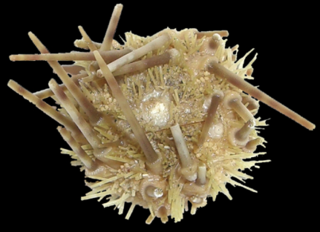
The Camarodonta are an order of globular sea urchins in the class Echinoidea. The fossil record shows that camarodonts have been in existence since the Lower Cretaceous.
Agassizia excentrica is a species of sea urchin of the family Prenasteridae. The species was first scientifically described in 1869 by Alexander Agassiz.
Caenopedina alanbakeri is a species of sea urchins of the Family Pedinidae. Their armour is covered with spines. Caenopedina alanbakeri was first scientifically described in 1989 by Rowe.

Caenopedina annulata is a species of sea urchins of the Family Pedinidae. Their armour is covered with spines. Caenopedina annulata was first scientifically described in 1940 by Ole Theodor Jensen Mortensen.
Caenopedina capensis is a species of sea urchins of the Family Pedinidae. Their armour is covered with spines. Caenopedina capensis was first scientifically described in 1923 by Hubert Lyman Clark.
Caenopedina depressa is a species of sea urchins of the Family Pedinidae. Their armour is covered with spines. Caenopedina depressa was first scientifically described in 1927 by Koehler.

Caenopedina diomedeae is a species of sea urchins of the Family Pedinidae. Their armour is covered with spines. Caenopedina diomedeae was first scientifically described in 1939 by Ole Theodor Jensen Mortensen.

Caenopedina hawaiiensis is a species of sea urchins of the Family Pedinidae. Their armor is covered with spines. Caenopedina hawaiiensis was first scientifically described in 1912 by Hubert Lyman Clark.
Caenopedina indica is a species of sea urchins of the Family Pedinidae. Their armour is covered with spines. Caenopedina indica was first scientifically described in 1903 by de Meijere.

Caenopedina mirabilis is a species of sea urchins of the Family Pedinidae. Their armour is covered with spines. Caenopedina mirabilis was first scientifically described in 1885 by Döderlein.

Caenopedina novaezealandiae is a species of sea urchins of the Family Pedinidae. Their armour is covered with spines. Caenopedina novaezealandiae was first scientifically described in 1964 by Pawson.
Caenopedina otagoensis is a species of sea urchins of the Family Pedinidae. Their armour is covered with spines. Caenopedina otagoensis was first scientifically described in 1968 by McKnight.
Caenopedina porphyrogigas is a species of sea urchins of the Family Pedinidae. Their armour is covered with spines. Caenopedina porphyrogigas was first scientifically described in 2009 by Anderson.
Caenopedina pulchella is a species of sea urchins of the family Pedinidae. Their armour is covered with spines. Caenopedina pulchella was first scientifically described in 1907 by Alexander Emanuel Agassiz and Hubert Lyman Clark.

Caenopedina superba is a species of sea urchins of the family Pedinidae. Their armour is covered with spines. Caenopedina superba was first scientifically described in 1925 by Hubert Lyman Clark.

Centrocidaris is a monotypic genus of sea urchins belonging to the family Cidaridae. The only species is Centrocidaris doederleini. Their armour is covered with spines. Centrocidaris doederleini was first scientifically described in 1898 by Alexander Agassiz.

Cidaris abyssicola is a species of sea urchin in the Family Cidaridae. Cidaris abyssicola was first scientifically described in 1869 by Alexander Emanuel Agassiz.

Clypeasteridae is a family of sea urchins in the order Clypeasteroida. This family was first scientifically described in 1835 by the Swiss-American biologist Louis Agassiz.

Caenopedina is a genus of sea urchins of the family Pedinidae.
Palaeostomatidae is a family of echinoderms belonging to the order Spatangoida.










